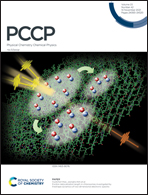Assessment of the UCST-type liquid–liquid phase separation mechanism of imidazolium-based ionic liquid, [C8mim][TFSI], and 1,4-dioxane by SANS, NMR, IR, and MD simulations†
Abstract
Liquid–liquid phase separation of binary systems for imidazolium-based ionic liquids (ILs), 1-alkyl-3-methylimidazolium bis(trifluoromethanesulfonyl)imide ([Cnmim][TFSI], where n represents the alkyl chain length of the cation), with 1,4-dioxane (1,4-DIO) was observed as a function of temperature and 1,4-DIO mole fraction, x1,4-DIO. The phase diagrams obtained for [Cnmim][TFSI]–1,4-DIO systems showed that the miscible region becomes wider with an increase in the alkyl chain length, n. For n = 6 and 8, an upper critical solution temperature (UCST) was found. To clarify the mechanism of the UCST-type phase separation, small-angle neutron scattering (SANS) experiments were conducted on the [C8mim][TFSI]–1,4-DIO-d8 system at several x1,4-DIO. The critical exponents of γ and ν determined from the SANS experiments showed that phase separation of the system at the UCST mole fraction occurs via the 3D-Ising mechanism, while that on both sides of UCST occurs via the mean field mechanism. Thus, the crossover of mechanism was observed for this system. The microscopic interactions among the cation, anion, and 1,4-DIO were elucidated using 1H and 13C NMR and IR spectroscopic techniques, together with the theoretical method of molecular dynamics (MD) simulations. The results on the microscopic interactions suggest that 1,4-DIO molecules cannot strongly interact with H atoms on the imidazolium ring, while they interact with the octyl chain of the cation through dispersion force. With a decrease in temperature, 1,4-DIO molecules gradually aggregate to form 1,4-DIO clusters in the binary solutions. The strengthening of the C–H⋯O interaction between 1,4-DIO molecules by cooling is the key to the phase separation. Of course, the electrostatic interaction between the cations and anions results in the formation of IL clusters. When IL clusters are excluded from 1,4-DIO clusters, liquid–liquid phase separation occurs. Accordingly, the balance between the electrostatic force between the cations and anions and the C–H⋯O interaction between the 1,4-DIO determines the 3D-Ising or the mean field mechanism of phase separation.
![Graphical abstract: Assessment of the UCST-type liquid–liquid phase separation mechanism of imidazolium-based ionic liquid, [C8mim][TFSI], and 1,4-dioxane by SANS, NMR, IR, and MD simulations](/en/Image/Get?imageInfo.ImageType=GA&imageInfo.ImageIdentifier.ManuscriptID=D1CP01940F&imageInfo.ImageIdentifier.Year=2021)


 Please wait while we load your content...
Please wait while we load your content...